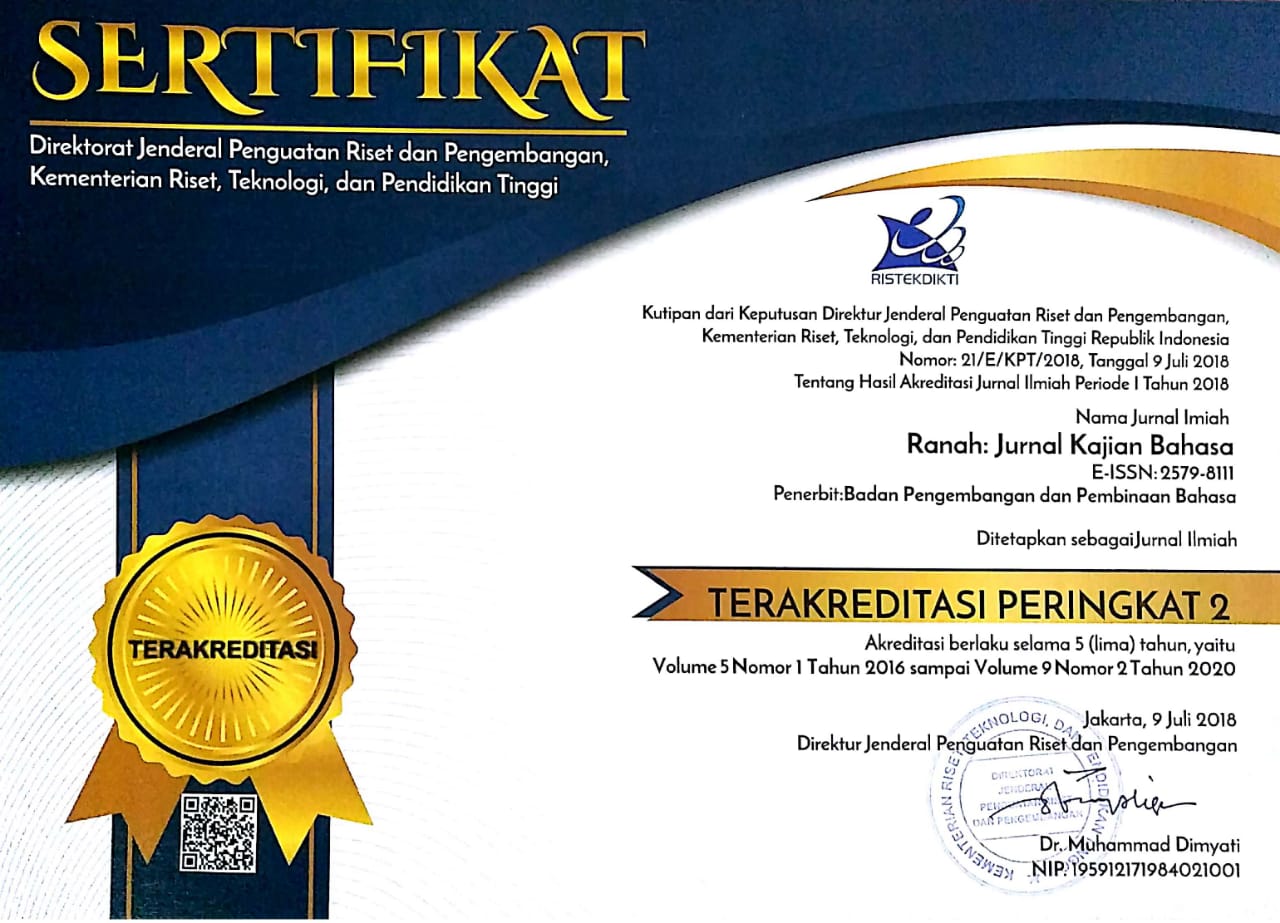Sociophonetic Analysis of the Characters' Speech in "Troubled Blood" by R. Galbraith
Abstract
British English has several regional varieties for almost every English county, e.g. Yorkshire, Lancashire, Cornwall, and so on. Each dialect can be distinguished by distinct vocabularies and pronunciation; for example the Cockney dialect use the glottal stop [?] instead of alveolar stop [t] in words like butter and bitter, so they are pronounced as [bΛ?ər] and [bɪ?ər]. These distinctive dialects’ pronunciation can be identified easily in spoken interaction, but it would be more problematic if it was represented in written text, such as in a novel. This paper attempts to analyse the distinguishing features of six intra-national varieties of British English found in the detective novel ‘Troubled Blood’ by Robert Galbraith, which is a pseudonym of J.K. Rowlings. The data for this study were taken from the speech samples of six characters from six regional dialects: Irish, Cornish, Scottish, Cockney, Eastender, and Essex. The speech samples data were extracted from the chapters in which the detective (Strike) or her partner (Robin) conversed with the chosen characters whose language backgrounds were stated clearly in the novel. The data were analysed by transcribing the speech samples phonetically, then from the transcriptions, phonetic features of each regional variation were identified using the theories of sociophonetic and regional variations. The interpretation of the sounds was based on the standard British English pronunciation. Results showed that a woman with East End dialect had some characteristics such as omission of initial h-sound, as in ‘appens, ‘ad, ‘eadaches, while a Scottish dialect was identified by the use of ‘havenae’ for ‘have not’. These results indicate that regional dialects or variations can be represented accurately in written text. Yet, it also suggests that the writer should have ample knowledge of each dialect to be able to represent distinctive variations in their writing.
Abstrak
Bahasa Inggris British memiliki beberapa variasi regional untuk hampir setiap wilayah Inggris, misalnya Yorkshire, Lancashire, Cornwall, dan sebagainya. Setiap dialek dapat dibedakan dengan kosakata dan pengucapan yang berbeda; misalnya dialek Cockney menggunakan glottal stop [?] alih-alih alveolar stop [t] dalam kata-kata seperti ‘butter’ dan ‘bitter’ sehingga diucapkan sebagai [bΛ?ər] dan [bɪ?ər]. Pengucapan dialek yang khas ini dapat diidentifikasi dengan mudah dalam interaksi lisan, tetapi akan lebih bermasalah jika direpresentasikan dalam teks tertulis, seperti dalam novel. Makalah ini mencoba menganalisis ciri-ciri pembeda dari enam dialek intra nasional Bahasa Inggris British yang ditemukan dalam novel detektif 'Troubled Blood' karya Robert Galbraith, yang merupakan nama samaran dari J.K. Rowling. Data untuk penelitian ini diambil dari sampel tuturan enam karakter dari enam dialek daerah: Irlandia, Cornish, Skotlandia, Cockney, Eastender, dan Essex. Data sampel ujaran diambil dari bab-bab di mana detektif (Strike) atau pasangannya (Robin) berbicara dengan karakter terpilih yang latar belakang bahasanya disebutkan dengan jelas dalam novel. Data dianalisis dengan mentranskripsikan sampel ujaran secara fonetis, kemudian dari transkripsi tersebut diidentifikasi ciri-ciri fonetik masing-masing variasi regional dengan menggunakan teori sosiofonetik dan variasi regional. Penafsiran suara didasarkan pada pengucapan bahasa Inggris standar. Hasil penelitian menunjukkan bahwa seorang wanita dengan dialek East End memiliki beberapa karakteristik seperti penghilangan bunyi h awal, seperti pada 'appens, 'ad, 'eadaches, sedangkan dialek Skotlandia diidentifikasi dengan penggunaan 'havenae' untuk 'have not' . Hasil ini menunjukkan bahwa dialek atau variasi daerah dapat direpresentasikan secara akurat dalam teks tertulis. Namun, hal itu juga mensyaratkan bahwa penulis harus memiliki pengetahuan yang cukup tentang setiap dialek untuk dapat mewakili variasi yang berbeda dalam tulisan mereka
Keywords
Full Text:
PDFReferences
Aitken, A. J. (1979). Scottish speech: a historical view with special reference to the Standard English of England. In A. J. Aitken & T. McArthurs (Eds.), Languages of Scotland (pp. 85-118). Chambers.
Bauer, M. (2011). The Practical Guide to Scottish Gaelic Pronunciation. Dublin: Akerbeltz.
Chappel, W. & Kanwit, M. (2022). Do learners connect sociophonetic variation with regional and social characteristics?: The case of L2 perception of Spanish aspiration. Studies in Second Language Acquisition, 44 (1), 185-209. https://doi.org/10.1017/S0272263121000115
Cole, A. (2021). Language and identity in the Cockney Diaspora : A sociophonetic and variationist study Amanda Cole Philosophy. UNiversity of Essex.
Culpeper, J. (2001). Language and Characterization: People in Plays and Other Texts. Longman.
Ethnologue. (2019). Language of the World.
Freeman, V. & De. Decker, P. (2021). Remote sociophonetic data collection: Vowels and nazalisation from self-recordings on personal devices. Language and Linguistics Compass, 15(7), e12345. https://doi.org/10.1111/lnc3.12435
Galbraith, R. (2018). Troubled Blood. Little Brown Company.
Harasta, J. (2017). "Because They Are Cornish": Four Uses of a Useless Language. Heritage Language Journal, 14 (3), 248-263. https://doi.org/10.46538/hlj.14.3.2
Helms, A. (2022). Sociophonetic analysis of mid front vowel production in Barcelona. In B. E. Bullock, C. Russi, & A. J. Toribio (Eds.), Open Romance Linguistics (Issue February). Language Science Press.
Hodson, J. (2014). Dialect in Film and Literature. Palgrave Macmillan UK. https://doi.org/10.1007/978-1-137-39394-4
Hodson, J. (2016). Talking like a servant: what nineteenth century novels can tell us about the social sistory of the language. Journal of Historical Sociolinguistics, 2(1), 27-46. https://doi.org/10.1515/jhsl-2016-0002
Holmes, J., & Wilson, D. (2017). An Introduction to Sociolinguistics. In G. Leech (Ed.), Language (Fifth, Vol. 70, Issue 3). Routledge. https://doi.org/10.2307/416511
Iles, Y. & Belmekki, A. (2020). The Use of Black English in American Literature: The Case of Mark Twain's Huckleberry Finn. Arab World English Journal, 4(1), 237-253. https://doi.org/10.24093/awejtls/vol4no1.19
Jenner, H. (2010). Henry Jenner's handbook of the Cornish language. Evertype.
Klanova, A. (2016). Sociophonetic study of substitutional glottalization in native English speakers. Univerzita Karlova v Praze.
Kress, G. (2000). Multimodality: Challenges to thinking about language. TESOL Quarterly, 34(2), 337-340. https://doi.org/10.2307/3587959
Maciej Baranowski. (2013). Sociophonetics. In R. Bayley, R. Cameron, & C. Lucas (Eds.), Oxford Handbook of Sociolinguistics (Issue Chapter 20, pp. 403-424). Oxford University Press. https://doi.org/10.1093/oxfordhb/9780199744084.013.0020
Mesthrie, R. (2017). Class, gender, and substrate erasure in sociolinguistic change: A sociophonetic of schwa in deracializing South African English. Language, 93(2), 314-346. https://doi.org/10.1353/lan.2017.0016
Montini, D., & Ranzato, I. (2021). The dialects of British english in fictional texts. In The Dialects of British English in Fictional Texts (Issue 2016). https://doi.org/10.4324/9781003017431
Morris, J. (2017). Sociophonetic variation in a long term language contact situation:/l/ darkening in Welsh-English bilingual speech. Journal of Sociolinguistics, 21 (2), 183-207. https://doi.org/10.1111/josl.12231
Morris, J. & Hejna, M. (2020). Pre-aspiration in Bethesda Welsh: A sociophonetic analysis. Journal of the International Phonetic Association, 50 (2), 168-192. https://doi.org/10.1017/-S0025100318000221
Oblak, I., & Pagliaro, A.L. (2022). Sigma, prestige and identity-case studies on the English of the North of England. Ideas Suplemento, 5(5), 85-90.
Planchenault, G. (2017). Doing dialects in dialogues: Regional, social and ethnic variation in fiction. In M. A. Locher & A. H. Jucker (Eds.), Pragmatics of Fiction (Issue February, pp. 265-296). De Gruyter Mouton. https://doi.org/10.1515/9783110431094-009
Ranzato, I. (2016). "Introduction: Reading Dialect Varieties in the Literary Macrotext." "Introduction: Reading Dialect Varieties in the Literary Macrotext," 11.
Roach, P. (2011). English Phonetics and Phonology. Cambridge University Press.
Sharma, D. (2021). Social class across borders: Transnational elites in British ideological splace. Journal of Sociolinguistics, 25(5), 682-702. https://doi.org/10.1111/josl.12520
Schleef, E., & Turton, D. (2018). Sociophonetic variation of like in British dialects: Effects of function, context and predictability. English Language and Linguistics, 22(1), 35-75. https://doi.org/10.1017/S136067431600023X
Thomas, E. R. (2011). Sociophonetics: an Introduction. Palgrave Macmillan UK. www.palgrave.com
Tolfree, L. (1999). South East London English: discrete versus continuous modelling of consonantal reduction. In P. Foulkes & G. Docherty (Eds.), Urban Voices (pp. 163-185). Arnold.
DOI: https://doi.org/10.26499/rnh.v11i2.5178
Refbacks
- There are currently no refbacks.








